Corporate Engagement
As expressed in our Investment Beliefs, we believe long-term value creation requires effective management of three forms of capital: financial, physical, and human. These beliefs support our corporate engagement activities; conducted privately and confidentially with portfolio companies.
We engage our portfolio companies to encourage them to consider how environmental, social, and governance (ESG) risks and opportunities affect their ability to create value over the long-term.
Our engagement activities fall under three broad categories:
- Routine: Ongoing interactions with companies, especially around annual meetings and post-meeting follow up. Routine engagements don’t overlap with ad hoc or initiative-based engagements.
- Initiative-based: These are related to CalPERS' strategic and core initiatives outlined in the Total Fund Governance & Sustainability 5-Year Strategic Plan (PDF).
- Event-driven: Triggered by specific events and are centered around controversies or governance concerns.
Process
We exercise our ownership rights to influence the governance of our portfolio companies. Our objective is to ensure that our portfolio companies are managed to create long-term, sustainable value. We prefer to work collaboratively with portfolio companies to clearly communicate our beliefs.
Identify
The following framework guides our engagement program:
- Principles and Policy: Are the issues supported by CalPERS Investment Beliefs, Governance & Sustainability Principles, or other Investment Policy?
- Materiality: Does the issue have impact on the company’s risk/opportunity within the portfolio framework?
- Definition and Likelihood of Success: Is success likely, in that our action will influence an outcome that can be measured? Can we partner with others to achieve success or would someone else be more suited to carry the issue?
- Capacity: Do we have the expertise, resources, and standing to influence an outcome?
Analyze
Our corporate governance team will perform a preliminary analysis of the issues before engaging with a portfolio company. We will review each company's public documents, which may include its annual report, integrated report, Securities and Exchange Commission (SEC) filings, sustainability reports, and any other publicly available information. We will also use ESG research provided by third-party vendors to complement our analysis.
After conducting a thorough review and analysis of the company and issue, we will determine whether a corporate engagement is still warranted based on our Investment Beliefs and Governance & Sustainability Principles. If so, we will proceed to request an engagement with the company.
Engage
We engage our portfolio companies confidentially through phone, letter, and/or in-person meetings. We have the following objectives as we engage portfolio companies:
- To gather facts about the issue(s) and express our concerns to the company
- To share CalPERS' Governance & Sustainability Principles and Investment Beliefs with the company
- To seek the company's perspective on the issue
- To seek a resolution to address our concerns related to the issue
Resolve
We will periodically review the company's progress towards a resolution to determine our next course of action.
- Positive Resolution: The company responds to our engagements and participates in an active constructive dialogue with us. In such instances, we will continue to monitor these companies to ensure they implement any commitments made.
- No Resolution: If we determine our engagement efforts have not been successful, we will exercise our shareowner rights consistent with our Governance & Sustainability Principles, which may include the following actions:
- Oppose ballot items raised at the company's annual general meeting
- File shareowner proposals at the company
- Implement a shareowner engagement campaign
- Collaborate with partners
- Make a public statement of dissatisfaction
Initiatives
Studies [1,2,3] have shown companies with diverse boards and executives tend to have better financial performance than less diverse companies. Better financial performance leads to better investment returns, which improves our ability to pay benefits.
Objective
In August 2016, our Board's Investment Committee adopted the Total Fund Governance & Sustainability 5-Year Strategic Plan (PDF) which identified improving corporate board diversity and inclusion as one of six strategic priorities of the Investment Office. The objective of this initiative is to improve corporate board diversity to enhance our total fund performance.
Consistent with our Governance & Sustainability Principles (PDF), we believe a company's board should reflect a diverse mix of skills, characteristics, backgrounds, and experiences. Our long-term goal is to ensure that all public companies we invest in have a level of board diversity that reflects each company's business, customer base, workforce, and society in general.
Proxy Voting Strategy
On a case-by-case basis we will withhold from nominating/governance committee members at companies that don't make commitments to improve board diversity. Separately, we generally support diversity proposals requesting the company to provide additional information and disclosure at the board, management and employee levels, and where its diversity lags those of its peers or the population.
Shareowner Campaigns
Additionally, we consider the following activities:
- We may run “Vote No” campaigns targeting individual directors at non-responsive companies surrounding our board diversity requests.
- We may file shareowner proposals and run proxy solicitations related to corporate board diversity at portfolio companies as appropriate.
Outcomes
- In fiscal 2022-23, globally we voted “against” 768 directors (nominating/governance committee members) at companies where staff identified diversity concerns related to board composition. This represents an increase in comparison to the 133 directors that we voted “against” in fiscal year 2021-2022.
- Since fiscal years 2017-2023, we've engaged 800 companies in the Russell 3000 index requesting they improve diversity on their boards (Figure 1). Of the 800 companies engaged, 629 companies (approximately 79%) have since added elements of board diversity that they did not have prior to our engagement.
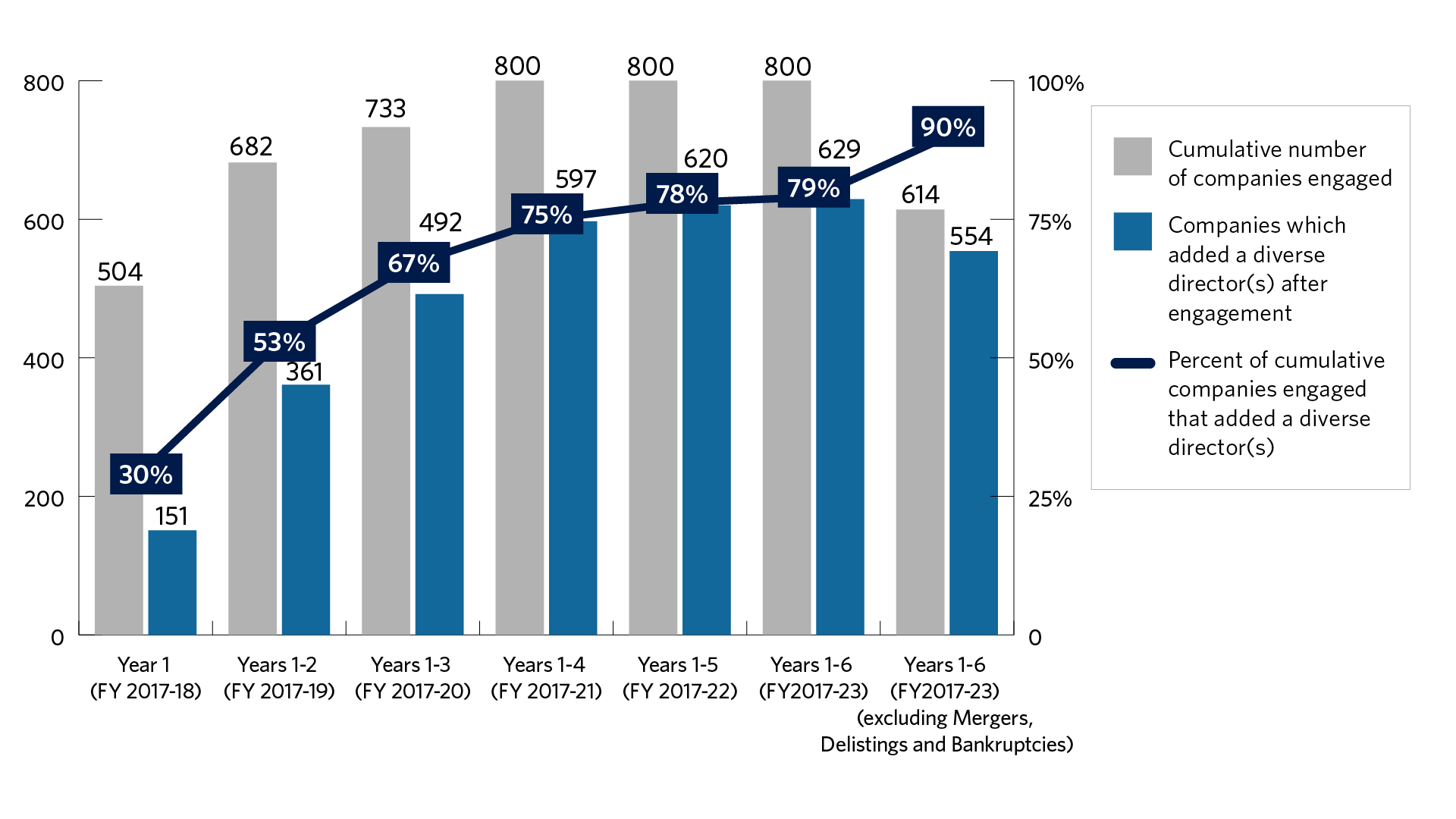
1McKinsey & Company, “Why Diversity Matters,” by Vivian Hunt, Dennis Layton, and Sara Prince, January 2015. http://www.mckinsey.com/business-functions/organization/our-insights/why-diversity-matters
2McKinsey & Company, “Delivering through Diversity” by Vivian Hunt, Sara Prince, Sundiatu Dixon-Fyle, Lareina Yee, January 2018. https://www.mckinsey.com/business-functions/organization/our-insights/delivering-through-diversity
3McKinsey & Company, “Diversity wins: How inclusion matter” by Sundiatu Dixon-Fyle, Kevin Dolan, Dame Vivian Hunt, and Sara Prince, May 2020. https://www.mckinsey.com/featured-insights/diversity-and-inclusion/diversity-wins-how-inclusion-matters
Climate risk presents systemic physical and transition risk to CalPERS' investments. This can affect investment returns.
Background
Our climate risk oversight work dates back to 2015 when we conducted a carbon footprint evaluation of the 10,000+ public companies within our portfolio. We found that the emissions were heavily concentrated – less than 100 companies were responsible for over half of the portfolio's greenhouse gas emissions (scope 1 & 2).
Presently, our engagement and proxy voting work related to climate risk oversight is organized into two initiatives:
- Top Emitters
- Climate Action 100+ (CA100+) Initiative
Top Emitters in Our Portfolio
Objective
We aim to hold directors accountable on climate risk oversight just as we do with diversity and executive compensation. The objective is to encourage top emitters in our portfolio to adopt climate risk best practices, consistent with the CA100+ engagement objectives.
Process
In 2023, we expanded our consideration of specific climate-related criteria to hold directors accountable at our highest 350 emitting companies in the portfolio. These companies account for over 85% of total portfolio scope 1 & 2 emissions and over 50% of scope 3 emissions.
Proxy Voting Strategy
In 2023, for the largest greenhouse gas (GHG) emitters in our portfolio, we implemented a voting practice to withhold votes from relevant committee members (and/or board leadership) who serve on a board that demonstrated a lack of board oversight related to climate-related risks. Consistent with our Climate Action 100+ engagements, we may use the Climate Action 100+ Benchmark to help inform our director votes.
Outcomes
In 2023, we voted “against” 289 directors at 97 of the top 350 highest-emitting companies in our portfolio.
Climate Action 100+
The CA100+ is an investor led initiative to engage systemically-important GHG emitters and other companies across the global economy that have significant opportunities to drive the clean energy transition and help achieve the goals of the Paris Agreement. The CA100+ dates back to 2017 and has more than 700 signatories with more than $68 trillion in assets. We lead engagement at 20 of the 171 focus companies, plus leadership responsibilities.
Objective
The objective of the CA100+ is to engage each focus company to seek the following:
- Improve the governance oversight of climate-related risks and opportunities
- Curb GHG emissions across the value chain to be consistent with net-zero by 2050 or sooner
- Strengthen climate-related financial disclosures in line with the Task Force on Climate-related Financial Disclosure (TCFD)
Proxy Voting Strategy
In 2022, we implemented an enhanced voting practice to consider specific climate-related criteria to help inform director votes at all CA100+ companies in our portfolio.
Outcomes
- Over 75% of CA100+ companies have now set a net zero by 2050 target or ambition
- Over 90% of CA100+ companies have taken steps to align reporting with Taskforce on Climate related Financial Disclosure (TCFD) recommendations
- Results and progress of the engagements are detailed in the most recent Climate Action 100+ Progress Report
- In 2022, we voted “against” 95 directors at 26 CA100+ portfolio companies
Shareowner Campaigns
If necessary, we will file or co-file climate shareowner proposals at portfolio companies.
- In 2019, we filed and co-filed climate risk shareowner proposals at four Climate Action 100+ companies.
- In 2020, we co-filed on one climate-related shareowner proposal and ran proxy solicitations for climate-related proposals at 10 portfolio companies that were flagged by the Climate Action 100+.
- In 2021, we filed and co-filed climate-related shareowner proposals at three CA100+ companies and ran proxy solicitations for climate-related proposals at six portfolio companies that were flagged by the CA100+.
- In 2022, we filed and co-filed climate related shareowner proposals at two CA100+ companies and ran proxy solicitation for climate-related proposal at one portfolio company that was flagged by the CA100+.
- In 2023, we filed and co-filed climate related shareowner proposals at two CA100+ companies and ran proxy solicitation for climate-related proposal at one portfolio company that was flagged by the CA100+.
In 2019, we launched a new Executive Compensation Analysis Framework (PDF) for evaluating executive compensation plans at our portfolio companies. View our Executive Compensation Analysis Framework: Frequently Asked Questions (PDF) for answers to commonly asked questions from our engagements on executive compensation with directors and management of our portfolio companies.
Process
We use our Executive Compensation Analysis Framework to evaluate and vote on executive compensation proposals. We'll also proactively engage companies where we've identified a potential pay for performance misalignment.
Proxy Voting Strategy
In 2020, we began withholding votes from directors who are compensation committee members in the same year that we voted against the advisory vote on executive compensation.
Outcomes
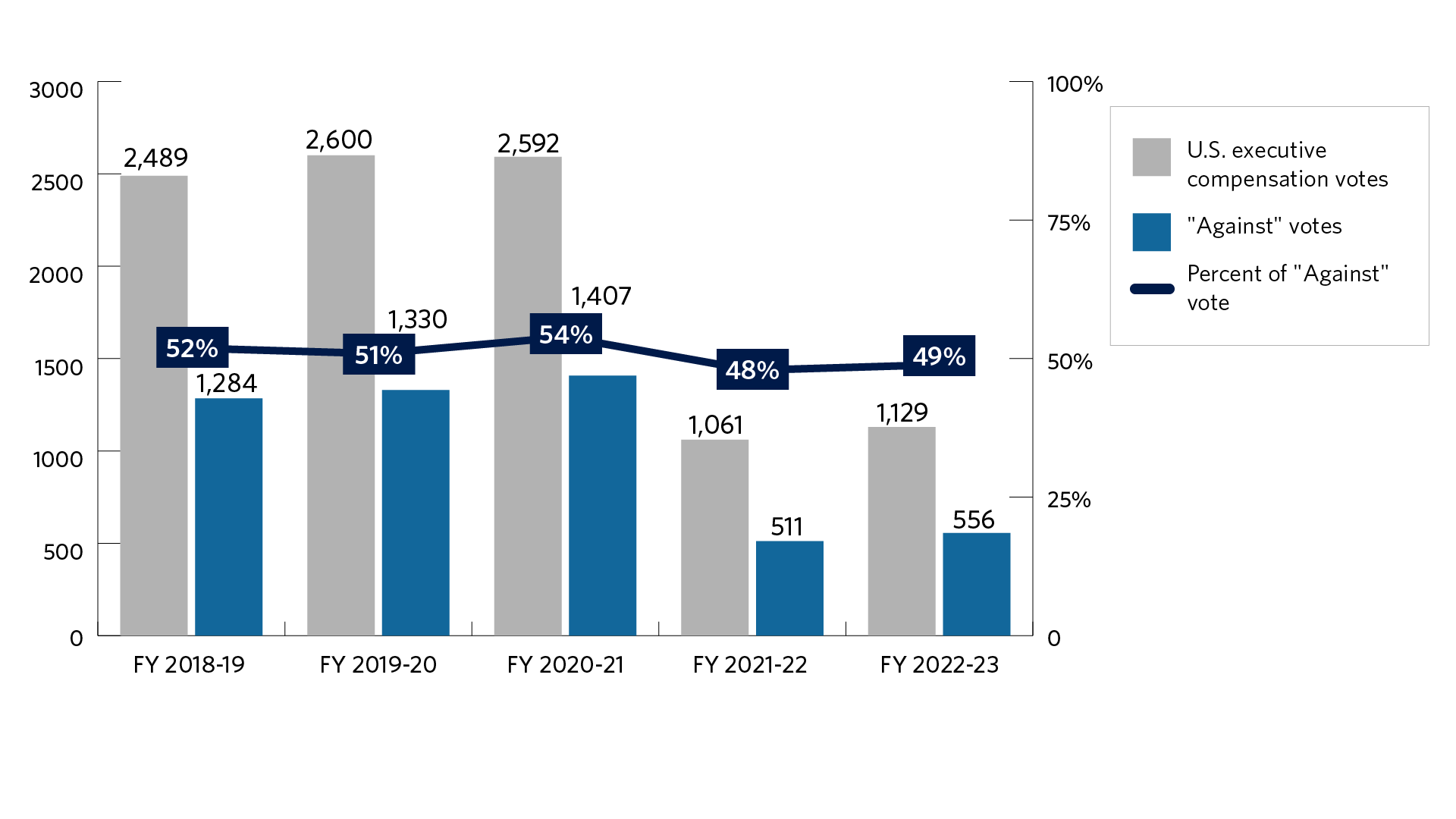
- During fiscal year 2022-2023, we voted against 49% of advisory vote on executive compensation proposals. Additionally, we voted against over 1,392 directors when voting against the advisory vote on executive compensation.
- During the 2023 proxy season staff engaged 65 large-cap companies with negative absolute one-year returns of -25% or more to discuss pay alignment in light of recent underperformance.
Japan is the second largest investment market in our global equity portfolio. Research shows Japanese companies have historically lagged their global peers on profitability, valuation, and board independence. Consistent with our Governance & Sustainability Principles, we believe that independent, competent, and diverse boards are the foundation to a sound governance structure and could help improve investment returns of Japanese companies. We believe strong governance practices increase the likelihood that companies will perform better over the long-term.
Background
Our work to advance corporate governance best practices in Japan dates back more than a decade. In 2014, we collaborated with a group of international institutional investors and wrote to many of our largest Japanese portfolio companies requesting that the board of directors be comprised of at least one-third independent directors by 2017. Subsequently, in 2015, we publicly supported the adoption of Japan's Corporate Governance Code and were one of the first U.S. signatories to disclose our commitment (PDF) to Japan's Stewardship Code in 2016. Japan's Stewardship Code aims to enhance long-term returns for investors through constructive engagement and dialogue with publicly traded Japanese companies.
Objective
Our goal is to improve board independence at Japanese portfolio companies by moving the market towards majority independent boards consistent with our Governance & Sustainability Principles (PDF).
Proxy Voting Strategy
In 2017, we implemented an enhanced voting practice for Japan to vote "against" non-independent directors when board independence is less than one-third.
New Proxy Voting Practice for 2023: While we acknowledge the increase in Japan board independence levels in recent years, we believe it’s now reasonable to begin applying a 50% minimum independence threshold for Japan. This threshold is consistent with our voting threshold in all other markets.
Outcomes
- We recognize the hard work and leadership by local market constituents that has been put into the corporate governance reforms in Japan. We continue to support their ongoing efforts.
- Independence levels for the 864 companies that we wrote letters to in 2017 requesting that they consider increasing the level of board independence to at least 1/3 have improved on par with the trend of the broader Japanese market.
- The percentage of Japanese companies with one-third board independence rose from 52% in 2018 to about 98% in 2023 (Figure 1).
- The percentage of Japanese companies with majority independent boards increased from 6% in 2018 to about 19% in 2023 (Figure 2).
- During the 2023 proxy season, we voted “against” 3,464 non-independent directors at 560 companies (of approximately 864 companies) due board independence concerns (Figure 3). This was a significant increase compared to our “against” votes in the 2022 proxy season due to our new proxy voting practice that applies a 50% minimum independence threshold for Japan.
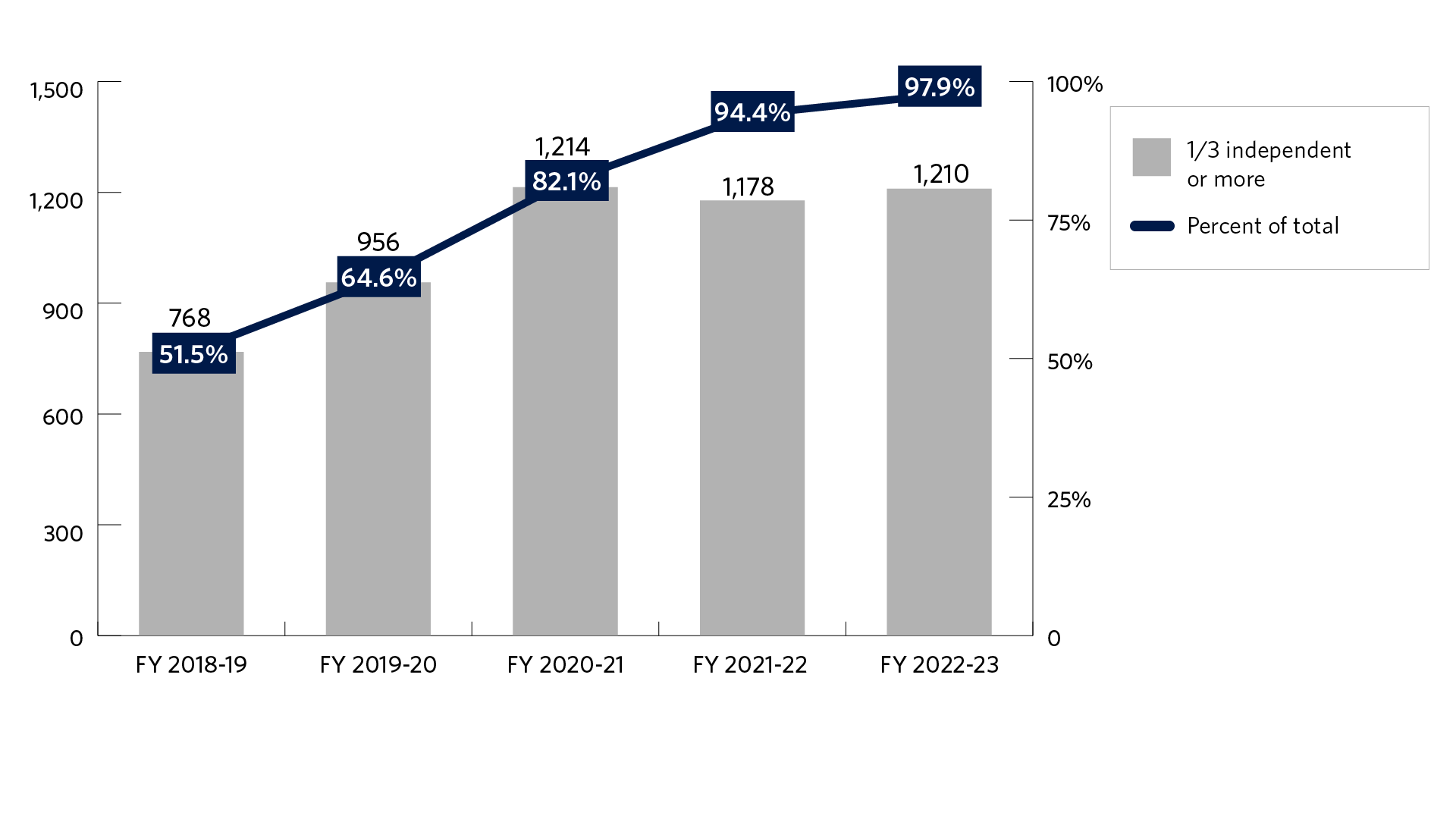
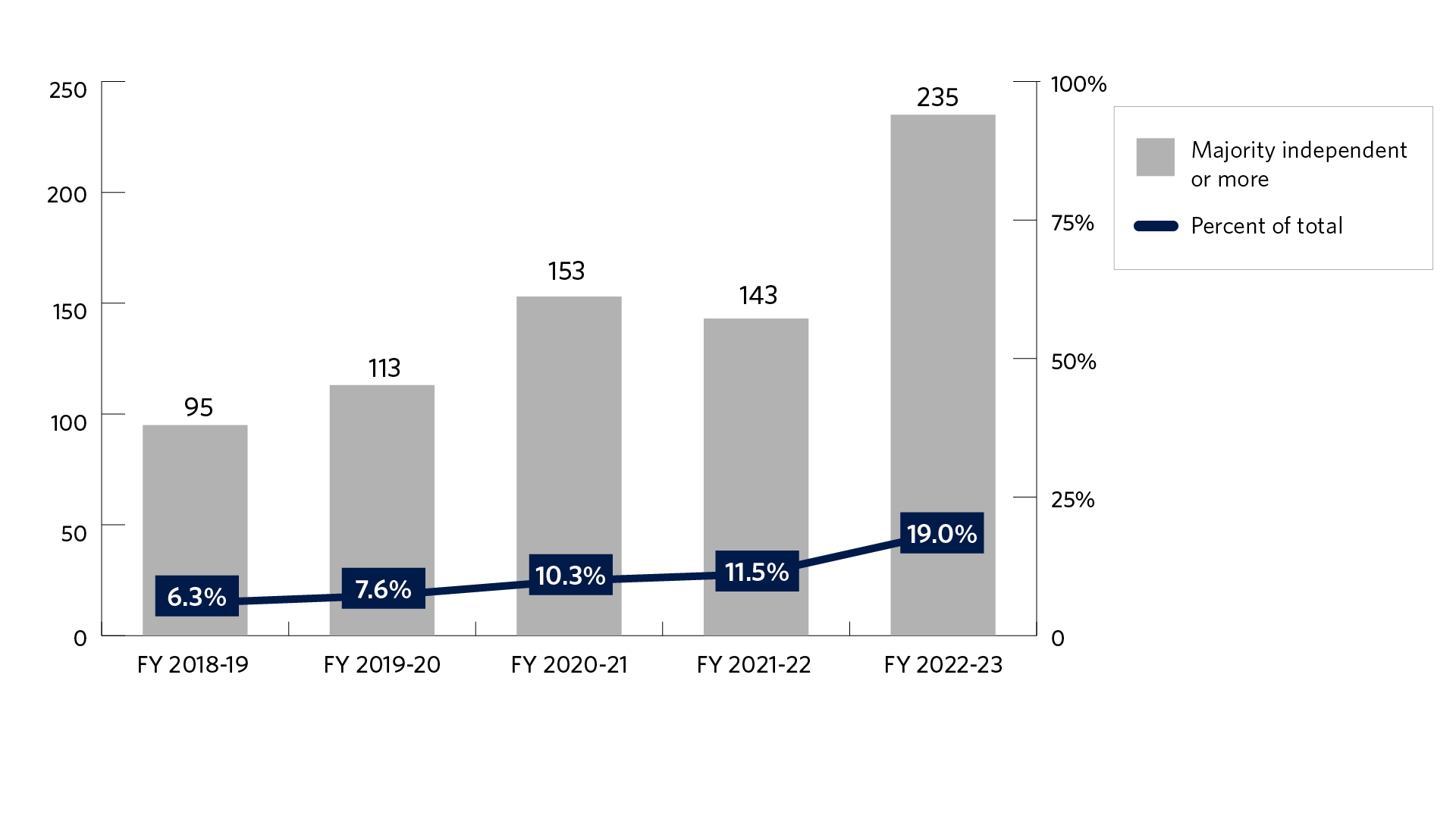
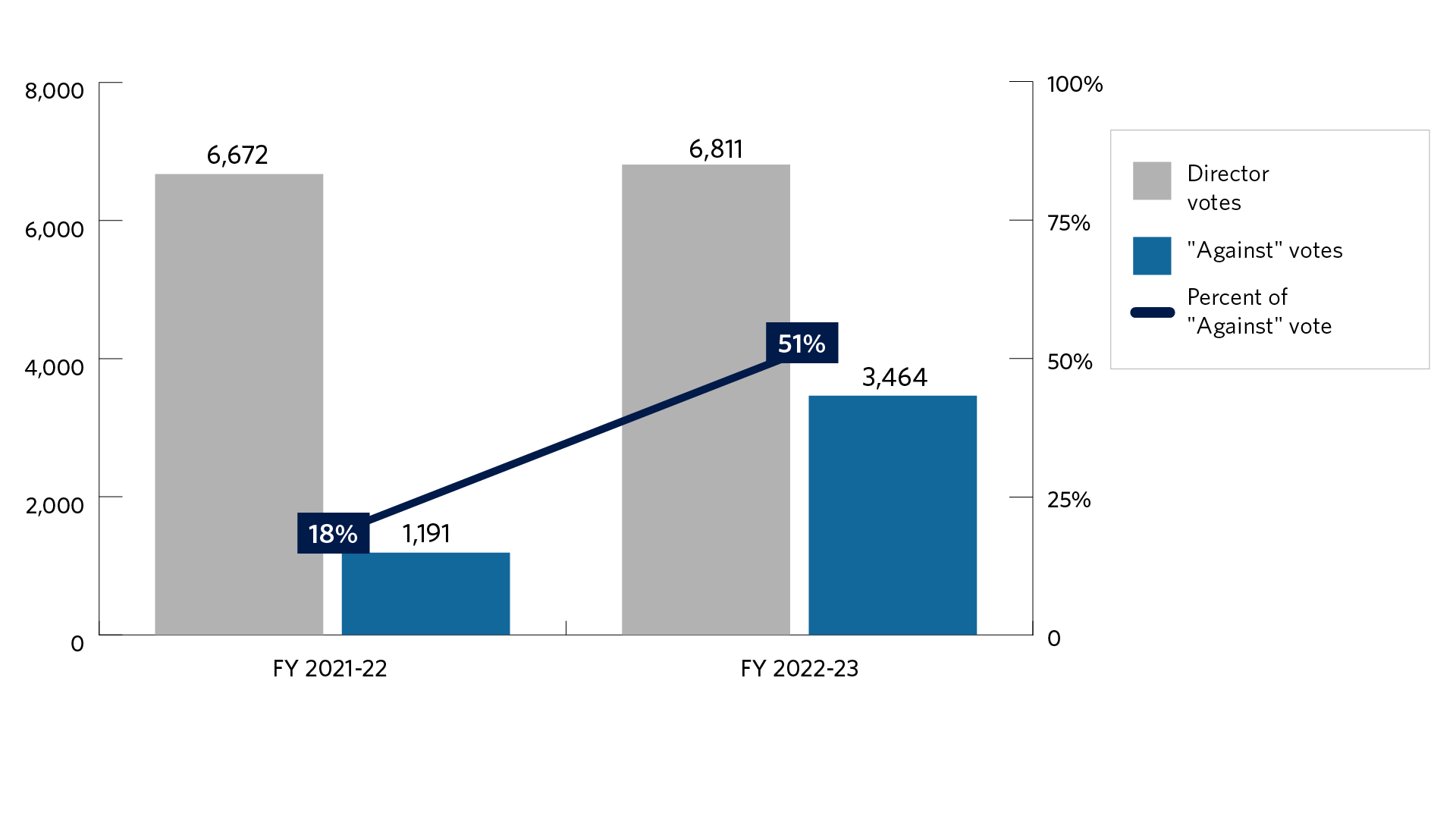
Corporate Governance
- About Us
- Corporate Engagement
- Proxy Voting